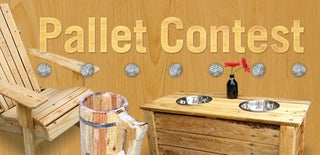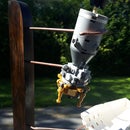Introduction: Canoe, Kayak Building Form and Steam Box From Recycled Pallets
I've built several canoes/kayaks over the years, often using salvaged and recycled parts, so when I saw an ad for free pallets on Kijiji, I figured it would be a good time to make an instructable on it. For me, canoe building is a free-form craft and it's rather easier than you may think. I don't use plans or templates and often rely on the rule of eye in creating them. It doesn't mean I don't do a whole lot of measuring, on the contrary. One crooked form can put your entire project out of shape leaving you with a wobbly craft. What I mean is that by employing a few rules, you can adapt this tutorial toward making a quality craft with the freedom to alter the length and breadth as you see fit.
This particular form is designed for a 13' hybrid canoe/kayak built completely out of recycled material. Now canoes are normally made out of long fiber, light weight material like cedar, but I'm building this one out of pine which, based on experience, is infinitely more difficult to steam bend due to its short fibers causing it to, more often than not, break. I say it's more difficult, but not impossible and the finished product will be as durable and lightweight as its cedar counterpart.
I'm planning this as a 2 part tutorial. Initially, I'd intended to create one instructable on the entire project, however there's so much detail that it would have ended up being 20+ steps long, so I've decided to break it up. This particular instructable is for the form, and steam box alone.
Step 1: Tools and Supplies
Tools;
- Drill and Bits
- Jigsaw table saw or hand saw
- measuring tape
- 2" and 2 3/4" deck screws
- combination square
Supplies;
- Wood pallets
- tire inner tube
- electric kettle
- shop vac extension tube
Step 2: Choosing Your Pallets
Now you may think that a pallet is a pallet is a pallet, but that simply isn't a fact. Tho the old 4x4' style is the most common type you'll see, but if you know where to look, you can find much larger pallets that will yield better quality wood, in greater lengths. After a quick search on Kijiji, I located a local motor sports store, that sells ATVs and sea-doos, and that was advertising free pallets. More often than not, they have to pay to dispose of them so they're more than glad to deliver them right to your door, provided, of course, you take an entire stack of them.
The pile I acquired were constructed with a variety of sizes. 1x3", 2x3", 2x6" and 2x4", all in lengths upwards of 6-8 feet. More than ample for my needs. I also ended up with a few pieces of OSD plywood and some good size pieces of poly sheeting that would be perfect for making a skin boat. Best of all, I ended up with over 200 Mending plates which, after figuring out how to remove them without damaging them, left me with a lot of good hardware for building.
Step 3: Building a Strongback
My boat design was about 13', and so I needed to create a platform to work on and set my form. That's where the strongback comes in to play. A strongback is simply a run of boards that's made to hold the weight of your boat as you're building it. All I did was take some 1x3" lengths and join them together with shorter pieces. On a 13' boat, one layer will do, however if you plan to build bigger, I'd suggest doubling up your wood for strength.
Next I built the legs by simply screwing a cross brace under the main beam, then attaching some 2x3" legs that were 30" long and 24" apart. I used some short 1x3" pieces to brace across the legs to prevent shifting, then ran some more down the outside of of all of the legs to stop it from collapsing forward or back. They're quick and dirty, but it really doesn't need anything more than that unless your plan is to keep the form for multiple boats, then you may want to build a bit sturdier.
Step 4: Creating Your Dimensions
Once you have your strongback built, you need to decide on the dimensions of your boat. There's a simple little formula that I use which is that, at it's widest point, your boat is roughly between 20-25% of it's total length. That means on a 13' boat, your width should be roughly between 32-40". This is by no sense a definitive number since many kayaks can be as narrow as 18", however, if it's your first time building, it'd be a good place to begin. My design was for a 30" beam.
For starters, I had to decide how many ribs I wanted in the boat, and their placement. There's a misconception that the ribs need to be evenly spaced along it's length. That's incorrect. For example, my design is a asymmetrical kayak/canoe hybrid, meaning the bow and stern will be enclosed with an oversize opening for passengers, with the bow being longer than the stern. That means that very little weight will be in the bow or stern, and so to reduce overall weight I can space the ribs out a bit more, and not lose any consistency in the shape. In the passenger compartment, it's better to have more ribs spaced closer together. This will help support the additional weight, and also go a long way to stopping the inevitable, "friend that's never been in a boat" putting his foot through the hull when he's climbing in.
Step 5: Creating Your Forms
For my forms, I like to start my measurements from the beam to the bow or stern, however I create my forms from the outside in, though length breadth and depth all play factors in my shaping. For the new builder, a depth of around 12-14" is a good place to start, but depending on the type of craft you intend to build, it can be as low as 8" and as tall as 20". Next, you have to decide on the arch of your hull, i.e. if you prefer a flat bottom like a prospector canoe, or the intense rocker of a white water canoe. For my hybrid, I opted for a slight rocker that went from 12" at the bow and stern, to 14" at the passenger compartment.
After deciding on the rocker, I needed to decide how many ribs I would have between the beam (widest part of the boat) to the bow. Knowing the distance from the beam to the bow allowed me to figure out the spacing I needed between each rib, and the width of each rib as well. I didn't want too dramatic of a taper, so I used a more graduated decrease in size by removing eight inches on each rib until I reached the last one before the bow where it tapers more abruptly. This gave me the streamlined effect I wanted, while leaving the overall shape somewhat rounder.
What to Make the Forms Out Of;
They don't have to be pretty. For the most part, I used some old OSD plywood that came with the pallets, but I didn't have enough. To compensate, I just took some 1x3" boards, joined them together and cut my forms out of that. Again, this is simply a jig to build your canoe on, so none of it has to be pretty. Just functional.
**Note On Form Shape;
There's really no rule here since this is where your own creativity comes in to play.. You can create a rounded hull, which is better for turning and maneuvering, or one with a definite peak which would assist with speed and stability. It's really up to you. Again, just make the shapes graduated as they span the length. What I do is take the first form at the bow, trace it on the next then size it's dimensions up so as to maintain the same overall shape and not end up with any weird dimples in the boat.
Steam Bending;
Lastly, you'll want to drill some 1" holes, evenly spaced around the inside edge of the forms. You can use these holes for lashing or clamping your ribs down as you steam bend them. I like to use old bike inner tubes for this job like you see in the third pic. Simply cut your inner tube into long strips, attach one end to your form, then as you remove your pieces from the steam bending box, your can press it around the form, and bind it with the rubber cord. This method is a bit harder to do on your own, but it's actually less damaging to the rib as opposed to clamping.
Step 6: The Bow and Stern
Creating the bow and stern is the easiest step in the entire process. All I do is cut it to the size and shape I want, then attach it right to the strongback, leaving a couple extra inches so that it can simply be sliced off when the hull is built. I'll show you more on that when I create the canoe tutorial, but it's sufficient to remember that, if you're creating an angled bow/stern, you'll need to figure in the extra length. The bow and stern boards I created were made using 1" pine.
Step 7: The Steam Box
The steam box is a very simple design. It's made of 1x6" pine boards, screwed together with 1x3" legs. Now, keeping in mind you're basically filling it with water, that water will need somewhere to go, so the back legs are actually a couple inches longer than the front, and a hole is drilled on the bottom to allow for drainage, so your wood doesn't end up sitting in a pool.
Next drill a 1.5" hole in the side of the box on a downward 45 degree angle. This is the inlet for your steam from your kettle. To funnel the steam into the box, I use an old shop vac extension tube that I've sliced a small section out of to make it fit seamlessly into the opening of the kettle.
Finally, drill a couple 2" holes in each end. These are the 'gloryholes' of the box where you put your pieces into. To avoid losing steam from your box, what I generally do is wrap the ends of my cut pieces with cloth, using that to plug up the extra space. It works very well, provided your seams join up and no steam escapes.
Step 8: Finished
That's it. Again, I've tried to keep it as simple as I can. You can spend upwards of $200 on pre-made forms, or buy plans and build them yourself, but nothing feels better than designing your boat, your own way, from beginning to end. With this instructable, you should be able to free build any boat shape and size you want as there are no set measurements. Just a few simple principals that will go a long way to creating a boat that's a reflection of you.
So I hope you enjoyed the instructable and thanks for checking it out.

Participated in the
Great Outdoors Contest

Participated in the
Epilog Challenge VI

Participated in the
Pallet Contest













